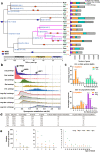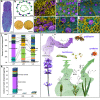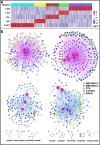The chromosome-based lavender genome provides new insights into Lamiaceae evolution and terpenoid biosynthesis
- PMID: 33642593
- PMCID: PMC7917091
- DOI: 10.1038/s41438-021-00490-6
The chromosome-based lavender genome provides new insights into Lamiaceae evolution and terpenoid biosynthesis
Erratum in
-
Correction: The chromosome-based lavender genome provides new insights into Lamiaceae evolution and terpenoid biosynthesis.Hortic Res. 2021 Apr 15;8(1):90. doi: 10.1038/s41438-021-00536-9. Hortic Res. 2021. PMID: 33859175 Free PMC article. No abstract available.
Abstract
The aromatic shrub Lavandula angustifolia produces various volatile terpenoids that serve as resources for essential oils and function in plant-insect communication. To better understand the genetic basis of the terpenoid diversity in lavender, we present a high-quality reference genome for the Chinese lavender cultivar "Jingxun 2" using PacBio and Hi-C technologies to anchor the 894.50 Mb genome assembly into 27 pseudochromosomes. In addition to the γ triplication event, lavender underwent two rounds of whole-genome duplication (WGD) during the Eocene-Oligocene (29.6 MYA) and Miocene-Pliocene (6.9 MYA) transitions. As a result of tandem duplications and lineage-specific WGDs, gene families related to terpenoid biosynthesis in lavender are substantially expanded compared to those of five other species in Lamiaceae. Many terpenoid biosynthesis transcripts are abundant in glandular trichomes. We further integrated the contents of ecologically functional terpenoids and coexpressed terpenoid biosynthetic genes to construct terpenoid-gene networks. Typical gene clusters, including TPS-TPS, TPS-CYP450, and TPS-BAHD, linked with compounds that primarily function as attractants or repellents, were identified by their similar patterns of change during flower development or in response to methyl jasmonate. Comprehensive analysis of the genetic basis of the production of volatiles in lavender could serve as a foundation for future research into lavender evolution, phytochemistry, and ecology.
Conflict of interest statement
The authors declare no competing interests.
Figures






References
-
- Upson, T. & Andrews, S. in SciTech Book News Vol. 28 (2004).
-
- Woronuk G, Demissie Z, Rheault M, Mahmoud SS. Biosynthesis and therapeutic properties of Lavandula essential oil constituents. Planta Med. 2011;77:7–15. - PubMed
-
- Lis-Balchin, M. Lavender: The Genus Lavandula (2002).
Grants and funding
LinkOut - more resources
Full Text Sources
Other Literature Sources
Research Materials
Miscellaneous

